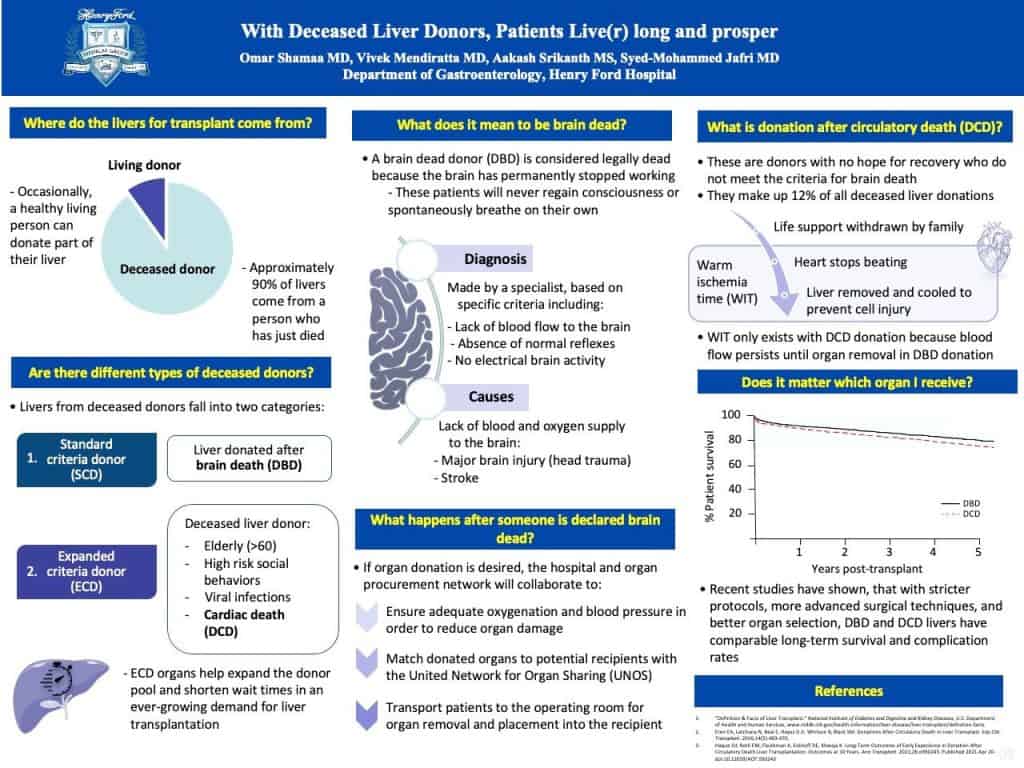With Deceased Liver Donors, Patients Live(r) Long and Prosper
Omar Shamaa MD, Vivek Mendiratta MD, Aakash Srikanth MS and Syed-Mohammed Jafri MD
Henry Ford Hospital
This presentation is an excerpt from the ALF 2021 Poster Competition. This competition showcases posters and a brief video created by early career investigators from across the country on six areas of educational focus: fatty liver disease, liver cancer, liver transplantation, pediatric liver disease, rare liver disease and viral hepatitis. Participants are tasked with translating complicated medical information into a poster which can be easily understood by patients or the public. Posters are reviewed by a formal panel of judges comprised of Medical Advisory Council members, Board Members and friends of ALF to select a winner in each category.

Where do the livers for transplant come from?
Approximately 90% of livers come from a person who has just died, called a deceased donor. Occasionally, a healthy living person can donate part of their liver, called a living donor. This process entails replacement of the recipients pre-existing diseased liver with part of the living donor’s healthy liver. Both the living donors and recipient’s liver will grow back to normal size shortly after the transplant.
Are there different types of deceased donors?
Livers from deceased donors fall into two categories, standard criteria donor livers (SCD), and occurs when the liver comes from a deceased donor who is declared brain dead. An expanded criteria donor (ECD), refers to livers that are considered less ideal because they are obtained from deceased donors who may be elderly, have high-risk social behaviors, or were exposed to viral infections (Hepatitis B or C exposure). It also includes organs donated after cardiac death. The term expanded. is used because an expansion of the donor pool has helped in shortening wait times in an ever-growing demand for liver transplantation
What does it mean to be brain dead?
A brain death donor is a person who is considered legally dead because their brain has permanently stopped working. These patients will never regain consciousness or spontaneously breathe on their own. The diagnosis Is made by a specialist, usually a neurologist or an intensivist, based on a specific set of criteria such as: Lack of blood flow to the brain, Absence of normal reflexes and brain electrical activity. Most common causes of brain death include major injury to the brain following head trauma or stroke.
What happens after someone is declared brain dead?
After someone is declared brain dead, and an organ is desired, the hospital and organ procurement network work together to safely transfer the donated liver, this entails ensuring adequate oxygenation and blood supply to the organ, and then matching the donated organs to potential recipients with the help of the United Network for Organ Sharing (UNOS).
What is donation after circulatory death (DCD)?
The other type of deceased donors, known as deceased after circulatory death refers to individuals with severe brain injury and no hope for recovery who do not meet the criteria for brain death. Typically, the patient’s family decide to withdraw life support; after the patient’s heart stops, the liver is removed and cooled to prevent injury. The time from the last heartbeat to organ cooling is called warm ischemia time, and shorter periods directly correlate with better transplant outcomes.
Does it matter which organ I receive?
Recent studies have shown, that with stricter protocols, more advanced surgical techniques, and better organ selection, Deceased brain death and Deceased circulatory death livers have comparable long-term survival and complication rates.
Last updated on December 1st, 2022 at 02:07 pm